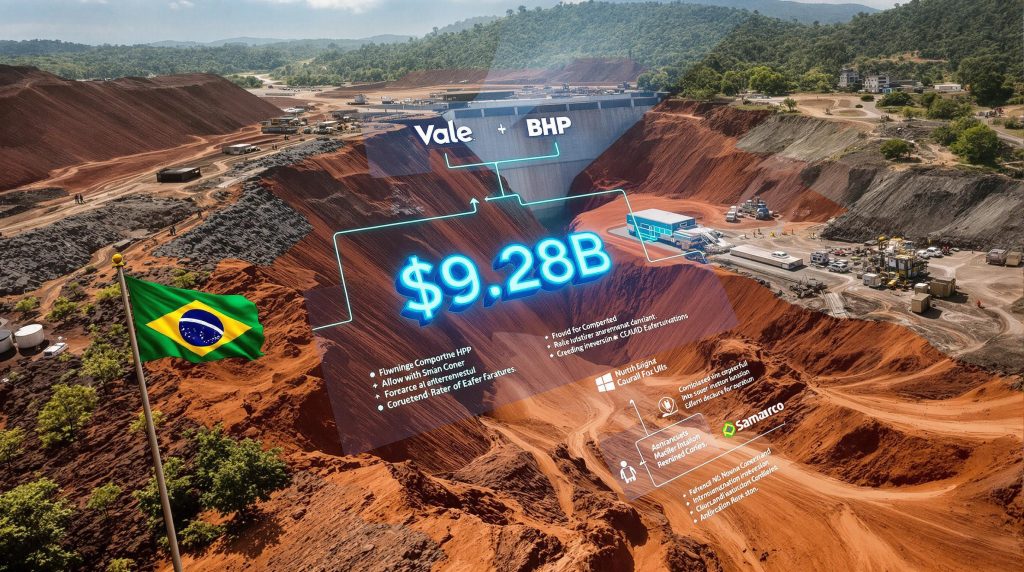Samarco's Emergence from Bankruptcy: Implications for the Mining Industry
In a significant development for the global mining sector, Samarco—the prominent Brazilian mining joint venture between industry giants Vale and BHP—has successfully navigated its way out of bankruptcy proceedings. This milestone event marks the conclusion of one of the mining industry's most complex financial restructurings, with far-reaching implications for environmental responsibility, corporate governance, and industry evolution insights. The Samarco exit from bankruptcy proceedings represents a critical turning point that will influence mining practices globally.
Why Did Samarco Enter Bankruptcy Proceedings in the First Place?
Samarco Mineração S.A., established as a 50-50 joint venture between Vale S.A. and BHP Group, has long been a significant player in Brazil's iron ore industry. The company's operations were centered in the mineral-rich state of Minas Gerais, where it produced iron ore pellets exported primarily to steelmakers worldwide.
On November 5, 2015, a catastrophic failure occurred at Samarco's Fundão tailings dam near the city of Mariana in Minas Gerais state. This disaster, considered one of Brazil's worst environmental catastrophes, unleashed approximately 43.7 million cubic meters of mining waste into the surrounding areas.
The immediate consequences were severe:
- Complete operational shutdown of Samarco's mining and processing facilities
- Massive environmental damage to the Rio Doce river basin
- Loss of human life and displacement of communities
- Destruction of livelihoods dependent on the river ecosystem
- An avalanche of litigation from affected communities, environmental groups, and government entities
The financial burden of addressing these consequences quickly overwhelmed Samarco's financial capabilities. With mounting legal claims, rehabilitation costs, and compensation demands—all while generating zero revenue due to suspended operations—the company's path toward judicial reorganization (Brazil's bankruptcy protection mechanism) became inevitable.
The Financial Burden
The collapse triggered billions in compensation claims and fines, creating an insurmountable debt burden that the company couldn't manage while operations remained suspended. This financial strain ultimately pushed Samarco to seek judicial restructuring (recuperação judicial) under Brazilian bankruptcy law in 2021, approximately six years after the disaster. The case offers valuable operational shutdown case study insights for the wider industry.
How Was Samarco's Bankruptcy Restructuring Achieved?
The road to restructuring Samarco's massive debt burden required extensive negotiation and complex legal maneuvering. According to Reuters reporting via Kitco News, Samarco successfully reorganized more than 50 billion reais (approximately $9.28 billion) in liabilities through the bankruptcy proceedings.
The Restructuring Process
The restructuring efforts were conducted under the supervision of courts in Minas Gerais state, where Samarco's primary operations are located. The process involved unprecedented coordination among approximately 10,000 creditors, ranging from major financial institutions to small businesses affected by the disaster.
Key elements of the restructuring included:
- Debt categorization – Classifying creditors into different priority groups
- Payment scheduling – Establishing realistic timelines for debt servicing
- Operational restart planning – Creating a framework for gradually resuming activities
- Environmental remediation commitments – Ensuring ongoing ecological restoration work
The process culminated in court approval to exit bankruptcy protection, marking a crucial turning point in Samarco's recovery journey. Furthermore, the joint venture restructuring mechanisms employed set new precedents for how mining partnerships handle crisis situations.
Restructuring by the Numbers
| Metric | Value |
|---|---|
| Total Liabilities Restructured | 50+ billion reais (~$9.28B) |
| Number of Creditors | ~10,000 |
| Years in Bankruptcy Process | ~2-3 years (formal process) |
| Recovery Period Since Incident | ~8 years |
| Exchange Rate Used | $1 = 5.3896 reais |
The sheer scale of this restructuring makes it one of the largest and most complex in Latin American mining history.
What Were the Legal and Financial Challenges?
The path through bankruptcy protection presented numerous unprecedented challenges for Samarco, its parent companies, and the Brazilian legal system itself.
Creditor Coordination Complexities
With approximately 10,000 creditors involved in the proceedings, the logistical challenges of managing claims, negotiations, and approvals were immense. These creditors represented diverse interests:
- International bondholders
- Brazilian financial institutions
- Equipment suppliers and service providers
- Local businesses affected by the operational shutdown
- Communities seeking compensation for damages
Regulatory Oversight
Brazil's bankruptcy proceedings require thorough regulatory scrutiny, particularly in cases with significant environmental implications. Samarco faced oversight from:
- Mining regulatory agencies
- Environmental protection authorities
- Federal and state prosecutors
- Judicial administrators appointed by the courts
Balancing Environmental Remediation with Financial Viability
Perhaps the most significant challenge was developing a restructuring plan that would:
- Ensure continued funding for environmental remediation efforts
- Provide fair compensation to affected communities
- Allow the company to eventually return to operational and financial viability
- Satisfy the diverse requirements of thousands of creditors
"The Samarco restructuring represents an unprecedented case where environmental disaster recovery had to be balanced with complex financial reorganization—creating a new playbook for how mining companies address catastrophic failures." — Brazilian mining sector analyst
What Are the Implications for Vale, BHP, and the Broader Industry?
The successful navigation through bankruptcy proceedings carries significant implications for Samarco's parent companies and the wider mining industry.
Parent Company Impact
For Vale and BHP, Samarco's exit from bankruptcy represents both a financial and reputational milestone:
- Financial clarity – The restructuring provides clearer visibility on future financial obligations
- Operational pathway – A framework now exists for potentially resuming iron ore production
- Reputational rehabilitation – Demonstrating follow-through on commitments to address the disaster's consequences
Industry-Wide Lessons
For the global mining sector, Samarco's journey through bankruptcy after an environmental disaster offers several instructive lessons:
- The true cost of environmental failures extends far beyond immediate cleanup expenses
- Joint venture structures require robust governance and risk management frameworks
- Operational restart after major incidents requires extraordinary stakeholder alignment
- Environmental and social governance (ESG) considerations have become fundamental to mining companies' license to operate
Comparison with Other Major Mining Incidents
| Company | Major Incident | Financial Impact | Recovery Timeline | Operational Outcome |
|---|---|---|---|---|
| Vale/BHP (Samarco) | 2015 Mariana Dam Collapse | $9.28B+ restructured | ~8 years | Partial restart with court approval |
| Vale | 2019 Brumadinho Dam Collapse | $7B+ settlement | Ongoing | Operations continued elsewhere |
| BHP | 2000 Ok Tedi Mine (Papua New Guinea) | $1.7B cleanup | ~20 years | Mine transferred to local ownership |
How Might Samarco's Recovery Shape Sustainability and Liability Practices?
The Samarco case has catalyzed fundamental changes in how the mining industry approaches sustainability, risk management, and corporate liability.
Tailings Management Revolution
Since the 2015 disaster, the industry has witnessed:
- Implementation of the Global Industry Standard on Tailings Management
- Increased independent monitoring and verification of tailings facilities
- Greater transparency through public disclosure of tailings dam conditions
- Technological advancement in monitoring systems and failure detection
These developments have accelerated mining decarbonisation trends as companies seek to reduce their environmental footprint.
Liability Insurance Transformation
The insurance market for mining operations has fundamentally changed:
- Higher premiums for tailings-related coverage
- More stringent technical requirements for insurability
- Expanded due diligence by insurers before providing coverage
- Growing emphasis on catastrophe modeling specific to tailings facilities
Environmental Compliance Enhancement
Regulatory frameworks have evolved considerably:
- Stricter requirements for environmental impact assessments
- More comprehensive emergency response planning
- Increased financial assurance requirements for potential remediation
- Greater community consultation and transparency
Additionally, mine reclamation developments have become central to rebuilding trust with affected communities.
What Lies Ahead for Samarco and Its Stakeholders?
With court approval to exit bankruptcy protection, Samarco now faces the challenging task of rebuilding its operations while maintaining its commitments to affected communities and the environment.
Operational Outlook
Samarco has already taken initial steps toward operational recovery:
- Limited restart of iron ore production at reduced capacity
- Implementation of new dry processing technology to minimize tailings production
- Rehabilitation of existing infrastructure and facilities
- Gradual rehiring and training of personnel
Ongoing Obligations
Despite exiting bankruptcy, Samarco maintains significant long-term commitments:
- Continued environmental monitoring and remediation along the Rio Doce watershed
- Support for affected communities through the Renova Foundation
- Implementation of enhanced safety measures across all operations
- Regular reporting to regulatory authorities on compliance with agreement terms
Market Position
Samarco's return to the iron ore market occurs in a dramatically different landscape:
- Increased global focus on high-grade, low-impurity iron ore products
- Growing premium for "green steel" raw materials
- Heightened customer scrutiny of suppliers' environmental practices
- Changed competitive dynamics among Brazilian and Australian producers
Frequently Asked Questions About Samarco's Bankruptcy Exit
What is the significance of Samarco leaving bankruptcy?
Samarco's exit from bankruptcy represents the culmination of years of financial restructuring, addressing approximately 50 billion reais ($9.28 billion) in liabilities resulting from the 2015 Mariana dam disaster. This milestone clears a significant obstacle to the company's continued recovery and provides greater certainty for its joint venture partners, Vale and BHP.
How did the joint venture aspect complicate or assist the restructuring?
The joint venture structure created both challenges and advantages during the restructuring process. While decision-making required alignment between two global mining giants with their own corporate priorities, it also meant Samarco had access to considerable technical expertise and financial resources that an independent miner might have lacked.
How long did the overall recovery process take?
While the formal bankruptcy proceedings lasted approximately 2-3 years, the broader recovery journey has spanned nearly eight years since the 2015 dam collapse. This timeline reflects the extraordinary complexity of addressing environmental remediation, community compensation, and financial restructuring simultaneously.
What broader lessons should mining companies draw from Samarco's experience?
Mining companies worldwide should recognize several critical lessons:
- Environmental disasters can create financial liabilities that dwarf operational assets
- Joint venture governance requires clear crisis management protocols
- Rebuilding stakeholder trust takes sustained effort over many years
- Environmental and social commitments must be maintained even during financial distress
- Recovery requires transparent engagement with diverse stakeholders
The Broader Ramifications of Samarco's Bankruptcy Resolution
Samarco's exit from bankruptcy protection represents more than just a financial restructuring—it marks a watershed moment in how the mining industry addresses catastrophic failures. The case demonstrates that even the largest mining companies are not immune to the financial consequences of environmental disasters, while also showing that recovery is possible through sustained commitment to addressing stakeholder concerns.
For industry observers, regulators, and communities alike, Samarco's journey offers valuable insights into the evolving standards of corporate accountability in the extractive sector. While the company's path forward remains challenging, its emergence from bankruptcy provides a framework for balancing financial viability with environmental and social responsibility.
As global mining continues to grapple with increasing stakeholder expectations and regulatory scrutiny, the Samarco exit from bankruptcy proceedings will likely serve as both a cautionary tale and a potential roadmap for navigating the aftermath of major operational failures.
Want to Catch the Next Major Mineral Discovery?
Discovery Alert's proprietary Discovery IQ model instantly notifies investors of significant ASX mineral discoveries, turning complex data into actionable insights before the broader market reacts. Explore historic examples of exceptional returns from major discoveries by visiting Discovery Alert's dedicated discoveries page.




